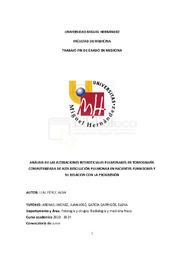Título :
Análisis de las alteraciones intersticiales pulmonares en tomografía computerizada de alta resolución pulmonar en pacientes fumadores y su relación con la progresión |
Autor :
Leal Pérez, Alba |
Tutor:
Arenas, Juan 
García Garrigós, Elena |
Editor :
Universidad Miguel Hernández |
Departamento:
Departamentos de la UMH::Patología y Cirugía |
Fecha de publicación:
2024-05-04 |
URI :
https://hdl.handle.net/11000/34060 |
Resumen :
Introducción: La existencia de una amplia variedad de alteraciones intersticiales en
tomografía computarizada de alta resolución (TCAR), y en concreto de lesiones quísticas
aéreas en pacientes fumadores con enfermedades pulmonares intersticiales difusas,
hacen que la interpretación de estos hallazgos sea compleja y que su relación con la
progresión esté poco estudiada.
El objetivo de nuestro estudio es analizar, en una serie retrospectiva de pacientes
fumadores o exfumadores con alteraciones intersticiales en TCAR, la relación de los
diferentes hallazgos visibles en un estudio basal con la progresión en una TC de
seguimiento separada al menos 1 año.
Hipótesis de trabajo: En pacientes fumadores o exfumadores con enfermedades
pulmonares intersticiales difusas en TC de alta resolución pulmonar, las diversas
alteraciones intersticiales pulmonares y en concreto las lesiones quísticas aéreas
permiten diferenciar los pacientes que van a mostrar progresión radiológica.
Material y métodos: Estudio observacional retrospectivo en el que se incluyen pacientes
fumadores o exfumadores valorados en comité de enfermedades intersticiales del
Hospital General Universitario Dr. Balmis de Alicante durante los últimos 3 años, con
enfermedad intersticial documentada en TCAR y un control de TC al menos 1 año
después. Se analiza la presencia de diferentes alteraciones intersticiales en la TC basal y
su relación con la progresión radiológica en la TC de control.
Resultados: Se incluyeron 80 pacientes, de ellos 51 presentaron progresión fibrótica. Los
quistes confluentes subpleurales, el enfisema por tracción, las bronquiectasias por
tracción y la panalización se asociaron a progresión con un VPP de >90%. Las bronquiectasias por tracción fueron el mejor predictor de progresión. Los quistes finos
no se asociaron a progresión.
Conclusión: En nuestra serie los quistes confluentes subpleurales, el enfisema por
tracción, las bronquiectasias por tracción y la panalización se asociaron a progresión
radiológica. Son necesarios más estudios que pongan de manifiesto el papel de los
hallazgos radiológicos en el pronóstico de la enfermedad que faciliten el manejo de las
enfermedades intersticiales en fumadores.
Introduc[on: CT scans of smokers with diffuse interstitial lung diseases frequently
exhibit a varied spectrum of aerated lung lesions that make the interpretation of these
findings intricate and their relationship with progression poorly understood. The aim of
our study is to analyze, in a retrospective series of smokers or former smokers with
interstitial abnormalities in CT scan, the relationship of different findings visible in a
baseline study with progression in a separate follow-up CT scan at least 1 year apart.
Hypothesis: In smokers or former smokers with diffuse interstitial lung diseases on CT
scan, the different interstitial abnormalities and particularly aerated lung lesions allow
differentiation of patients who will demonstrate radiological progression
Material and methods: Retrospective observational study including smokers or former
smokers assessed in the interstitial diseases multidisciplinary commitee at Dr. Balmis
University General Hospital of Alicante over the past 3 years who had documented
interstitial disease on high resolution CT and a follow-up CT scan at least 1 year later. The
presence of different interstitial abnormalities at baseline CT scan and their relationship
with radiological progression on follow-up CT scan were analyzed.
Results: Fiuy-one out of 80 patients included were judged to show fibrotic progression.
Confluent cystic lesions, traction emphysema, traction bronchiectasis, and
honeycombing were associated with progression with a positive predictive value of
>90%. Traction bronchiectasis was the best predictor of progression. Thin-walled cysts
were not associated with progression.
Conclusions: In our series, confluent cystic lesions, traction emphysema, traction
bronchiectasis, and honeycombing were associated with radiological progression. Further studies are needed to elucidate the role of radiological findings in the prognosis
of the disease, which would facilitate the management of interstitial lung diseases in
smokers.
|
Palabras clave/Materias:
Enfermedad intersticial pulmonar
Fibrosis pulmonar
Tomografía computarizada
RX
Tabaquismo
Inters al lung disease
pulmonary fibrosis
Computed tomography
X ray
Smoking |
Área de conocimiento :
CDU: Ciencias aplicadas: Medicina |
Tipo de documento :
info:eu-repo/semantics/bachelorThesis |
Derechos de acceso:
info:eu-repo/semantics/openAccess |
Aparece en las colecciones:
TFG- Medicina
|
 La licencia se describe como: Atribución-NonComercial-NoDerivada 4.0 Internacional.
La licencia se describe como: Atribución-NonComercial-NoDerivada 4.0 Internacional.
.png)
